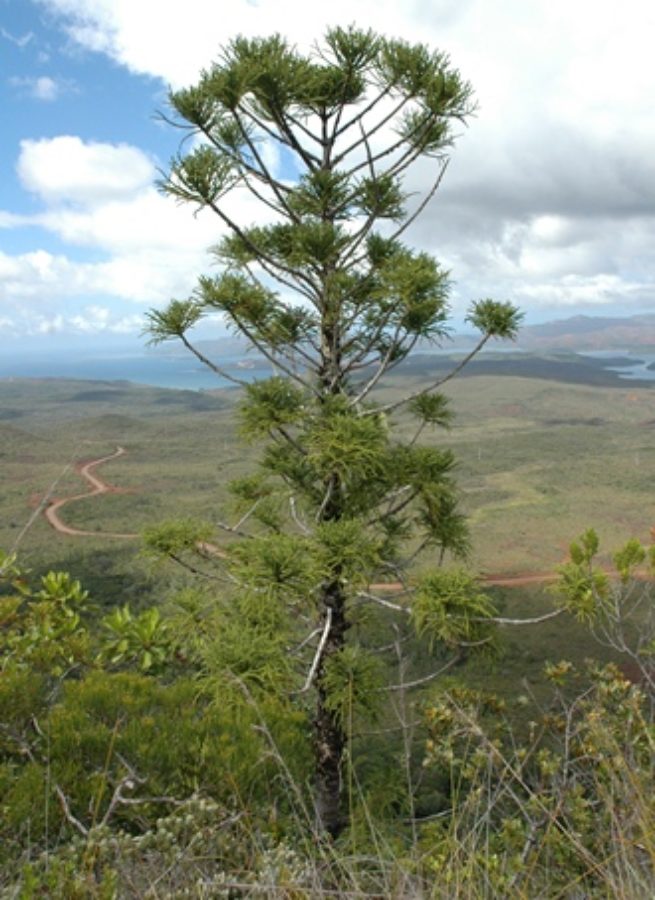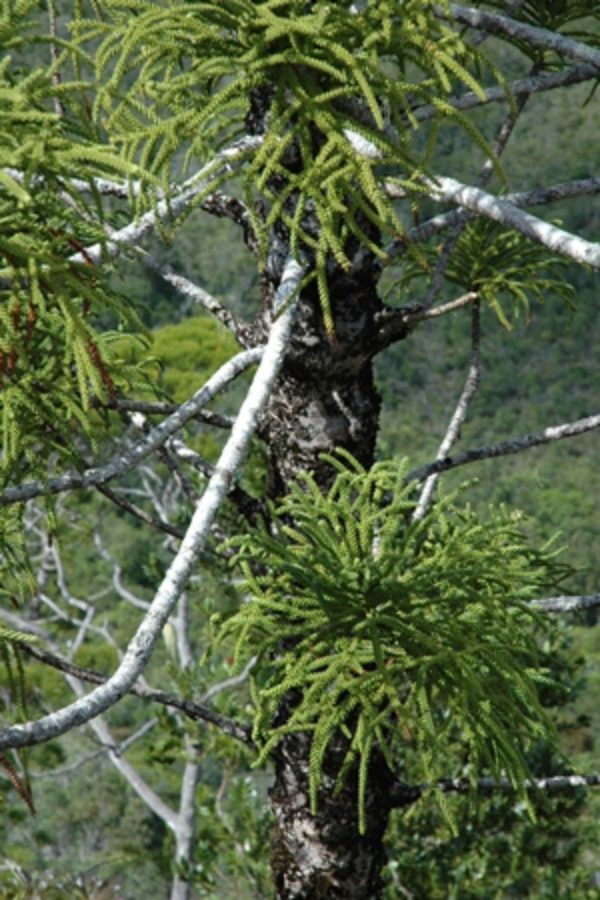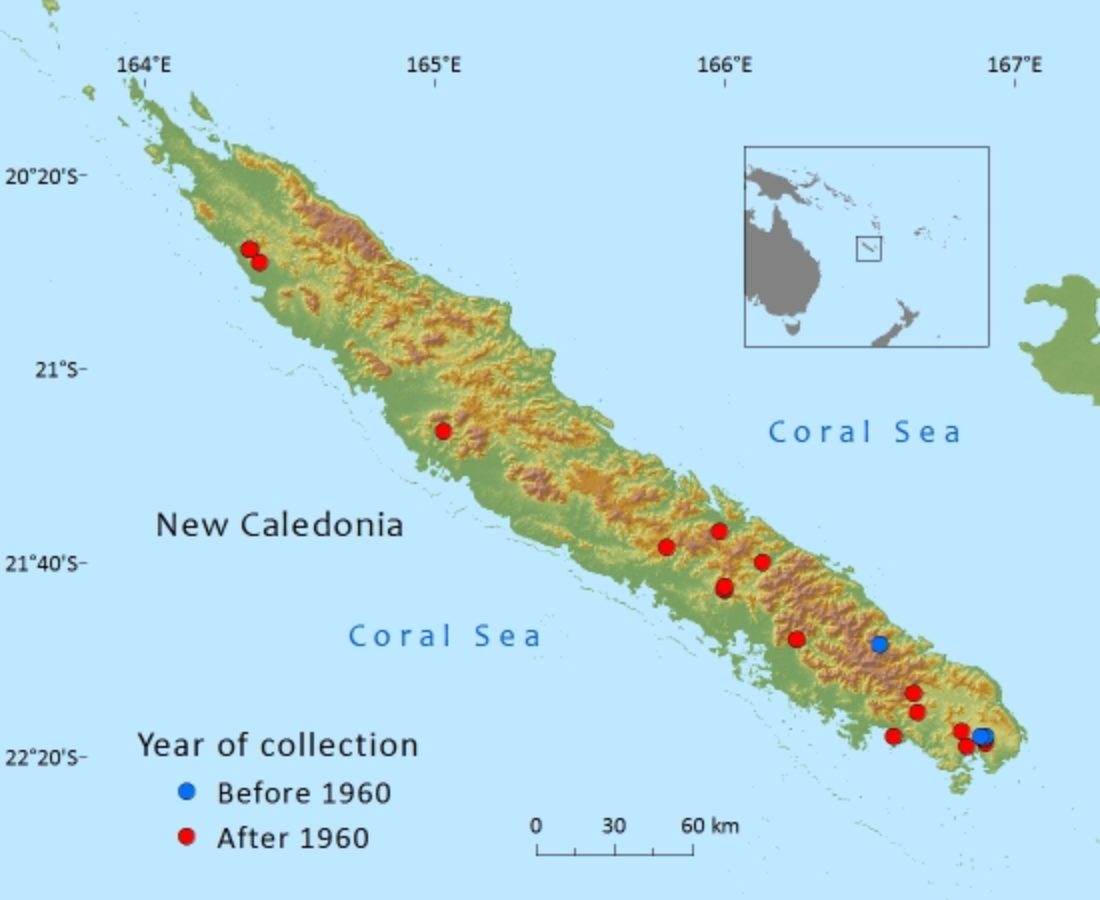Araucariaceae
Araucaria biramulata
One of 13 species of Araucaria endemic to New Caledonia where it occurs on the main island of Grande Terre; threats such as mining and fire are restricting regeneration and leading to fragmentation
Description
Habit
Monoecious tree to 30m tall, to 0.8m d.b.h. at maturity; trunk straight. Crown In mature trees conical or columnar but open, apex rounded or pyramidal, sometimes wider than the lower crown. Bark to 2cm thick, exfoliating in horizontal strips, forming horizontal bands or flakes in the largest trees.
Foliage
Leaves on mature trees of two kinds: adult and semi-juvenile. Adult leaves have a rhythmic variation in leaf size and spread along foliage branchlet; the size shape and range is ovate-broadly lanceolate, 5–10 × 3–6mm, apex incurved. Those on the penultimate branches shorter than or scarcely exceeding the diameter of their attachment base. Stomata on adult leaves on both surfaces, 10–14 discontinous rows each side of keel.
Cones
Male pollen-cones confined to higher parts on primary branches, terminal, initially erect but pendulous when shedding pollen. Cones cylindrical, initially straight becoming curved at maturity, 60–70 × 15–20mm. Female seed-cones terminal on short, stout foliage branches which widen below the cone, usually solitary, sometimes 2–3 together, erect. Mature cones green, subglobose, usually slightly longer than wide, 9–11 × 8–10cm., with a truncate apex. Seeds obovoid-oblong, 20–25 × 8–10mm, ripening light brown.
Key characters
Araucaria biramulata has the unique combination of characters which include: adult leaves on the penultimate branches shorter than or scarcely exceeding the diameter of their attachment base; rhythmic variation in adult leaf size and spread along foliage branchlets; lateral extensions at the base of adult axis leaves absent. The most similar species are Araucaria bernieri, A. scopulorum and A. humboldtensis.
References and further reading
- de Laubenfels, D. J. (1972). Gymnospermes. In: Aubréville, A. & Leroy, J.-F. (eds.), Flore de la Nouvelle-Calédonie et Dépendances, 4. Paris: Muséum National d’Histoire Naturelle. 167 p.
- Gaudeul, M., Rouhan, G., Gardner, M.F. & Hollingsworth, P.M. (2012). AFLP markers provide insights into the evolutionary relationships and diversification of New Caledonian Araucaria species (Araucariaceae). American journal of Botany 99(1):68-81.
- Jaffre, T., Bouchet, P. & Veillon, J.-M. (1998). Threatened plants of New Caledonia: Is the system of protected areas adequate? Biodiversity & Conservation 7(1): 36.
- Jaffré, T., Munzinger, J. & Lowry, P.P. (2010). Threats to the conifer species found on New Caledonia's ultramafic massifs and proposals for urgently needed measures to improve their protection. Biodiversity & Conservation 19(5):1485-1502.
- Manauté, J., Jaffré, T., Veillon, J.–M. & Kranitz, M. (2003). Revue des Araucariaceae de Nouvelle-Calédonie. IRD, Nouméa
- Nasi, R. (1982). Essai pour une meilleure connaissance et une meilleure comprehension des Araucariacées dans la végétation Calédonienne. Nouméa: École Nationale des Ingénieurs des Travaux des Eaux et Forêts, Centre Technique Forestier Tropical. 134 p., 10 plates, 44 p. appendices.
- Thomas, P. (2010). Araucaria biramulata. In: IUCN 2012. IUCN Red List of Threatened Species. Version 2012.1. www.iucnredlist.org . Downloaded on 29 June 2012.





